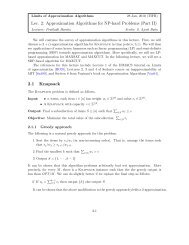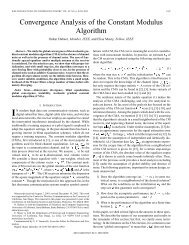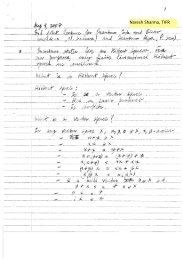Geometric Facility Location Problems
Geometric Facility Location Problems
Geometric Facility Location Problems
You also want an ePaper? Increase the reach of your titles
YUMPU automatically turns print PDFs into web optimized ePapers that Google loves.
Pinaki Mitra<br />
Dept. of CSE<br />
IIT Guwahati
Heron’s Problem<br />
• HIGHWAY FACILITY LOCATION<br />
<strong>Facility</strong><br />
High Way<br />
Farm A<br />
Farm B
Illustration of the Proof of Heron’s<br />
Theorem<br />
p<br />
q<br />
s<br />
r<br />
r’ l<br />
d(p,r) + d(q,r) = d(p’,q)<br />
p’<br />
d(p,r’) + d(q,r’) = d(p’,r’) + d(q,r’) >= d(p’,q)
MINIMAX FACILITY LOCATION<br />
Given n points in the plane representing customers<br />
(plants, schools, towns etc..) it is desired to determine<br />
the location X (another point in the plane) where a<br />
facility should be located so as to minimize the<br />
distance from X to its furthest customer.<br />
The problem has an elegant and succinct geometrical<br />
interpretation: “Find the smallest circle that encloses a<br />
given set of n points.”<br />
The center of the circle is<br />
Precisely the location of X<br />
+<br />
The smallest<br />
circle enclosing a<br />
set of points
The minimum enclosing circle can be computed from<br />
the Furthest Neighbor Voronoi Diagram. [Shamos]<br />
The correctness of the above algorithm was<br />
established by [Bhattacharya & Toussaint]. Their<br />
argument is based on the following property of the<br />
minimum enclosing circle :<br />
The minimum enclosing circle of a set S of n points is<br />
either determined by the diameter of the point set S or<br />
by three points on the convex hull of S, where those<br />
three points form an acute angled triangle.
Furthest Neighbor Voronoi Diagram can be<br />
computed from the projection of the upper hull of the<br />
point set lifted on the paraboloid z = x 2 + y 2 .<br />
z<br />
q<br />
(x 1<br />
,y 1<br />
, x 12<br />
+y 12<br />
))<br />
y<br />
p<br />
(x 1<br />
,y 1<br />
)<br />
(x,y) (x,y, x 2 +y 2 )<br />
x
But the computation of Furthest Neighbor Voronoi<br />
Diagram is lower bounded by the computation of the<br />
convex hull of n points i.e., Ω (nlogn).<br />
But this lower bound doesn’t hold for the minimum<br />
enclosing circle.<br />
In fact we can compute the minimum enclosing circle<br />
of a set of n points in θ(n) time by solving three<br />
variable Convex Program. [Meggido]<br />
The result holds for any fixed dimensional point set.
Here (x 1<br />
,y 1<br />
), (x 2<br />
, y 2<br />
), …., (x n<br />
,y n<br />
) are the set of points for which we have to<br />
compute the minimum enclosing circle.<br />
Let (x,y) be the center of the minimum enclosing circle and let r be its radius.<br />
Then we have the minimum enclosing circle problem formulated as the<br />
following optimization problem:<br />
Minimize r 2<br />
Subject to: (xx i<br />
) 2 + (yy i<br />
) 2 ≤ r 2 i = 1, 2, …, n<br />
If we substitute z = x 2 + y 2 – r 2 then we have the following convex<br />
programming formulation of the problem:<br />
Minimize x 2 + y 2 – z<br />
Subject to: 2xx i<br />
2yy i<br />
+ z + (x i<br />
2<br />
+ y i2<br />
) ≤ 0 i = 1, 2, …, n<br />
Thus we have to minimize a quadratic function over a set of linear<br />
constraints involving 3 variables.
FermatWeber Problem<br />
Problem Definition:<br />
For a given set of m points x 1<br />
, x 2<br />
, …, x n<br />
with each x i<br />
∈ R d find a<br />
point y from where the sum of all Euclidean distances to the x i<br />
’s<br />
is the minimum.<br />
This problem is also known as <strong>Geometric</strong> 1Median problem :<br />
arg min<br />
n<br />
∑<br />
d<br />
y ∈ R i=<br />
1<br />
x<br />
i<br />
−<br />
y<br />
The special case when n = 3 and d = 2 arises in the<br />
construction of Minimal Steiner Trees and was originally<br />
posed as problem by Torricelli.
a<br />
f<br />
120°<br />
b<br />
c<br />
For 3 coplanar points a, b, c if each angle of the triangle abc is less tan 120 ° the<br />
Fermat Point f is a point inside the triangle which subtends 120° an angle to all<br />
three pairs of points. Otherwise if any angle of the triangle abc is greater than<br />
then Fermat Point is the point making that angle.<br />
For 4 coplanar points if a point is inside the triangle formed by the other three<br />
points then geometric 1median is that point. Otherwise all 4 points form a<br />
convex quadrilateral and the geometric 1median is the intersection point of<br />
both the diagonals and also known as Radon Point.<br />
1 med
If we restrict d = 1 , i.e., for the 1dimensional case then the geometric 1<br />
median coincides with the median.<br />
Again if we consider the problem in L 1<br />
metric with d = 2, i.e., in 2dimension<br />
we can combine the optimal solutions of two 1 dimensional problems to<br />
obtain the optimal solution of the original problem.<br />
x<br />
The method extends for any value of d in L 1<br />
metric ,i.e., we can decompose<br />
the problem in d one dimensional problems and combine their optimal<br />
solution to obtain the optimal solution of the original problem.<br />
In L 2<br />
metric Weiszfeld’s algorithm iteratively computes the geometric 1<br />
n<br />
median problem : x<br />
y<br />
i+<br />
1<br />
y<br />
∑<br />
j=<br />
1<br />
= n<br />
∑<br />
j=<br />
1<br />
x<br />
x<br />
j<br />
j<br />
j<br />
−y<br />
1<br />
−y<br />
i<br />
i
KMedian<br />
Given a set S of n points in the plane we have to locate a set F of k facilities<br />
that partitions the set S in k partitions N(f i<br />
) i =1,2, …, k so that for any site s j<br />
∈ N(f i<br />
) [neighborhood of f i<br />
] being served by the facility f i<br />
the following sum<br />
is minimized:<br />
k<br />
∑<br />
∑<br />
i= 1 s ∈N<br />
( )<br />
j f i<br />
dist(<br />
f<br />
i<br />
,<br />
s<br />
j<br />
)<br />
where<br />
S<br />
=<br />
k<br />
N(<br />
f i<br />
)<br />
i=<br />
1<br />
and<br />
N( f ) N(<br />
f ) = φ,<br />
1≤<br />
i<br />
j<br />
i<br />
<<br />
j<br />
≤<br />
k
In kmedian problem the elements for the set F can be any k<br />
sites in R d in the unrestricted case. Sometimes we restrict the<br />
kmedian problem such that F ⊆ S, i.e., input point sites. Both<br />
of these problems are NPHard. [Meggido & Supowit]<br />
So our goal should be the design of efficient approximation<br />
algorithms for these problems. Here we will restrict our attention<br />
to the restricted version of the problem.<br />
Restricted version of our facility location can still be classified<br />
into two subcategories:<br />
(a) Uncapacitated kmedian problem<br />
(b) Capacitated kmedian problem
A common assumption used when dealing with location problems is that<br />
facilities are uncapacitated and can thus service any number of demand<br />
destinations. But the assumption may be unrealistic in many applications<br />
and thus in capacitated facility location an upper bound is provided on the<br />
number of demand destinations serviced by each facility.<br />
Now we can formulate these problems using ILP as follows:<br />
Minimize<br />
n<br />
∑<br />
i=<br />
1<br />
n<br />
∑<br />
j=<br />
1<br />
dist ( s , s ) x<br />
i<br />
j<br />
ij<br />
Subject to:<br />
n<br />
∑ x ij<br />
= 1<br />
i=<br />
1<br />
n<br />
∑x<br />
ij<br />
≤<br />
j=1<br />
C<br />
i<br />
j =1,2,...,<br />
i =1,2,...,<br />
n<br />
n<br />
n<br />
∑i<br />
y = k<br />
i=1<br />
y<br />
i<br />
− x ij<br />
≥ 0<br />
i =1,2,...,<br />
n<br />
j =1,2,...,<br />
n
y i<br />
∈{0,1}<br />
xij<br />
∈{0,1}<br />
i = 1,2,...,<br />
n j =1,2,...,<br />
n<br />
The indicator variable y i<br />
denotes if the site s i<br />
is selected as<br />
the facility or not.<br />
The indicator variable x ij<br />
denotes if the facility at the site s i<br />
serves the customer at site s j<br />
.<br />
Since ILP is NPComplete the usual technique is to relax the<br />
integrality constraint , i.e., replace the above two constraints<br />
by:<br />
0 ≤ y ≤ 1<br />
0 x ≤1<br />
≤ ij<br />
i<br />
i =1,2,...,n<br />
i = 1,2,...,<br />
n j =1,2,...,<br />
n
Then we solve the LPrelaxation of the ILP. After that the<br />
fractional solution is cleverly rounded maintaining the feasibility<br />
and some bound is established w.r.t Z* LP<br />
≤ Z* ILP<br />
For rectilinear 1median problem Ω(nlogn) lower bound was<br />
established by [Bajaj].<br />
As far as upper bounds are concerned there are O(n 1.5 log 4 n)<br />
time algorithm for arbitrary weighted points and O(nlog 4 n) time<br />
algorithm for equally weighted point set was exhibited by<br />
[ElGindy & Keil]<br />
Thus even in L 1<br />
metric there are big gaps between these upper<br />
and lower bounds.<br />
All these pose several new directions of future research.
Line <strong>Facility</strong><br />
In many practical applications we may be interested in locating<br />
a line facility rather than locating a point facility.<br />
For example we may have to construct a road in some<br />
residential area so that it is convenient to most of the residents.<br />
Then this road design is the same as locating a line facility<br />
among a set of sites for residents.<br />
There can be many variations of these problems in various<br />
metric. The L 2<br />
approximation of this problem, i.e., where we<br />
have to minimize the sum of the squares of the perpendicular<br />
distances is the well known Regression Line Problem.
Given a set of data points (x 1<br />
, y 1<br />
), (x 2<br />
, y 2<br />
), …., (x n<br />
, y n<br />
) we have to find the<br />
equation of the straight line y = ax + b that minimizes the L 2<br />
error, i.e.,<br />
Minimize<br />
Here the variables are in fact a and b. So we have two unknowns and we<br />
require at least two equations to solve. They are obtained from the minima<br />
criterion after taking partial derivatives w.r.t. a and b respectively:<br />
The result can be extended for any dimensional data. For example in d<br />
dimensions we have to find the Regression Hyperplane a 1<br />
x 1<br />
+ a 2<br />
x 2<br />
+ … +<br />
a d<br />
x d<br />
= b. Thus we have to<br />
Minimize<br />
n<br />
∑<br />
i=<br />
1<br />
2<br />
[ yi − ( axi<br />
+ b)]<br />
=<br />
n<br />
∑<br />
i=<br />
1<br />
d<br />
[ b − ∑<br />
j=<br />
1<br />
a<br />
j<br />
∂E<br />
∂a<br />
x<br />
i<br />
j<br />
]<br />
2<br />
E<br />
∂E<br />
= 0 , = 0<br />
∂b<br />
=<br />
E
Thus we have d unknowns a 1<br />
, a 2<br />
, …, a d<br />
. They are solved from the following<br />
system of equations:<br />
∂E<br />
∂a<br />
1<br />
∂E<br />
= 0,<br />
∂a<br />
2<br />
∂E<br />
= 0,...,<br />
∂<br />
a d<br />
= 0<br />
For L 1<br />
approximation of the problem we have to<br />
Minimize<br />
n<br />
∑<br />
i=<br />
1<br />
| b<br />
d<br />
−∑<br />
j=<br />
1<br />
a<br />
j<br />
x<br />
i<br />
j<br />
| =<br />
E<br />
This absolute value function is not a linear function. But we can easily<br />
convert it to a standard LP problem as follows [Chvatal]:<br />
Minimize<br />
Subject to:<br />
n<br />
∑<br />
i=<br />
1<br />
b<br />
e i<br />
d<br />
−∑<br />
j=1<br />
−b<br />
+<br />
d<br />
j=1<br />
a<br />
∑<br />
j<br />
a<br />
j<br />
x<br />
x<br />
i<br />
j<br />
i<br />
j<br />
≤ e<br />
i<br />
≤ e<br />
i<br />
i =1,2 ,...,<br />
i =1,2 ,...,<br />
n<br />
n
For L ∞<br />
approximation of the problem we have to<br />
Minimize<br />
max<br />
i<br />
| b −<br />
d<br />
∑<br />
j=<br />
1<br />
a<br />
j<br />
x<br />
i<br />
j<br />
|<br />
This can be directly formulated into LP as follows:<br />
Minimize<br />
z<br />
Subject to:<br />
z<br />
d<br />
+∑a<br />
j<br />
x ≥b<br />
j=1<br />
i<br />
j<br />
i =1,2 ,...,<br />
n<br />
z<br />
d<br />
−∑<br />
j=1<br />
a<br />
j<br />
x<br />
i<br />
j<br />
≥−b<br />
i =1,2 ,...,<br />
n<br />
The problem of L 1<br />
and L ∞<br />
approximation problem was first posed<br />
By Fourier. Subsequently many good algorithms for computing L 1<br />
and L ∞<br />
approximation were proposed by [Bloomfield & Steiger].
Similar type of problems for line facility concerns:<br />
i) Locating a line facility that minimizes the maximum distance<br />
from a set of sites.<br />
ii) Locating a line facility that minimizes the sum of the distances<br />
from a set of sites.<br />
There are several possible extensions of these problems.

















